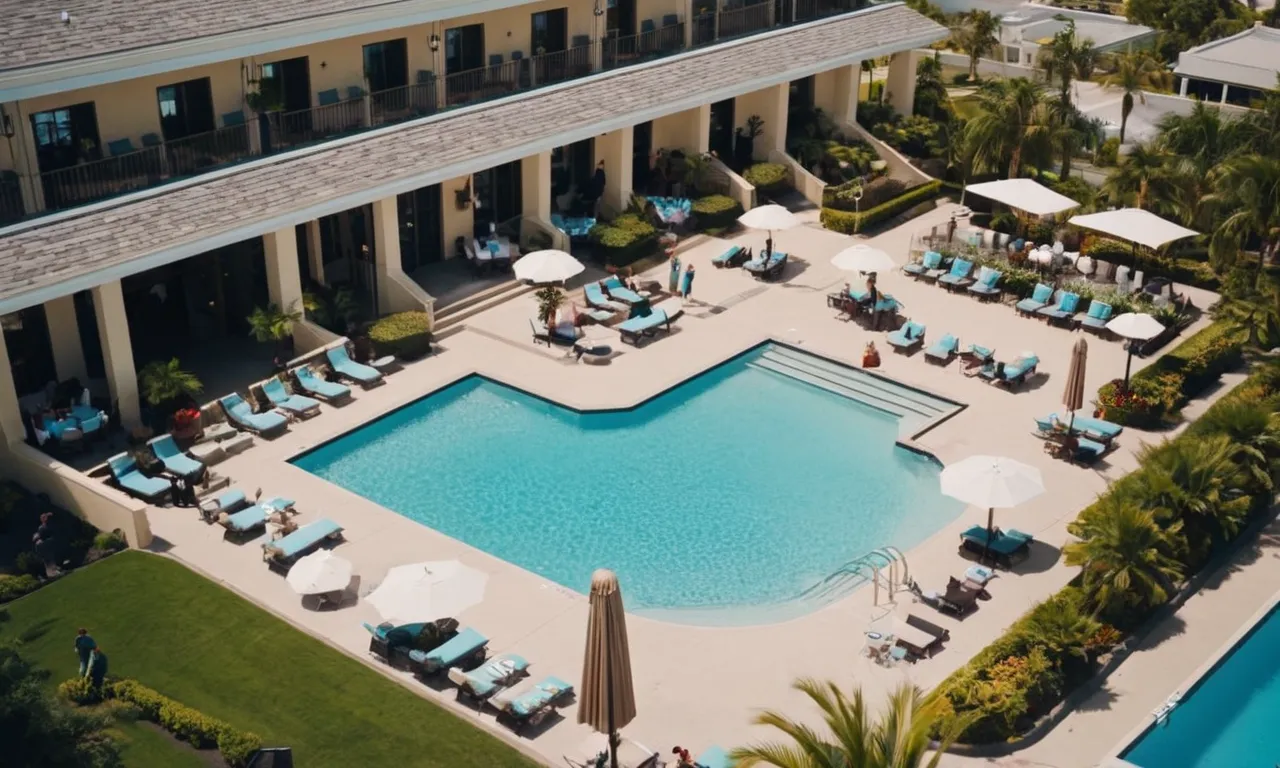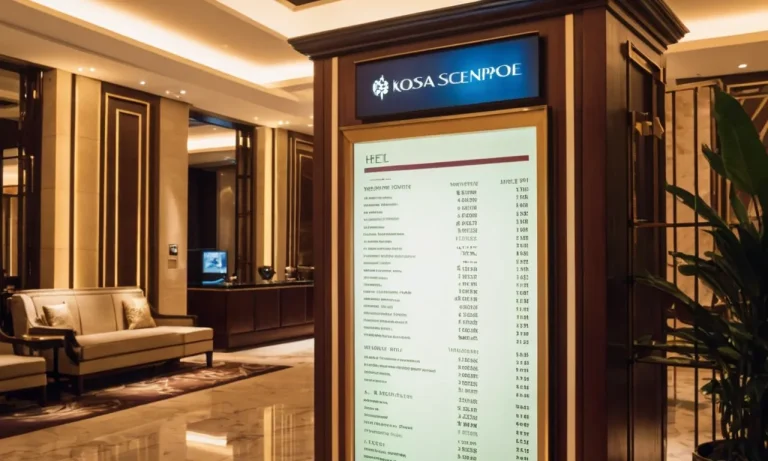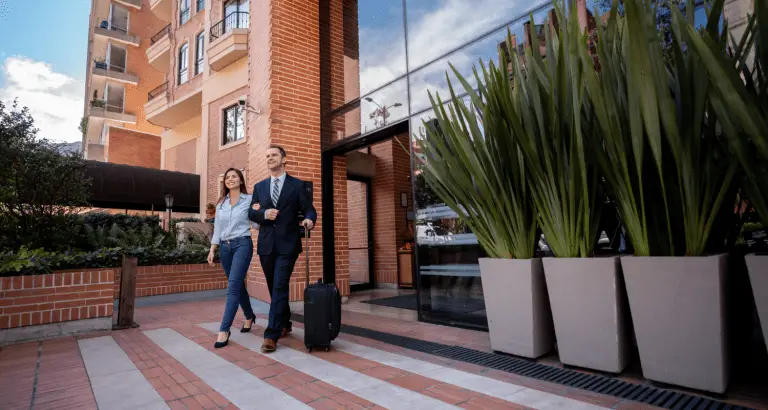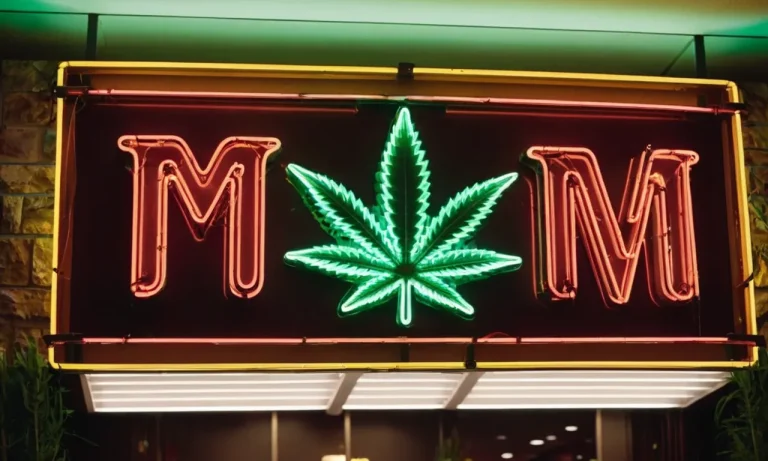What Is A Good Occupancy Rate For A Hotel?
In the ever-competitive hospitality industry, achieving a healthy occupancy rate is crucial for a hotel’s success and profitability. Occupancy rate, a key performance indicator, measures the percentage of available rooms occupied over a given period.
It serves as a barometer for a hotel’s popularity, pricing strategy, and overall operational efficiency.
If you’re short on time, here’s a quick answer to your question: A good occupancy rate for a hotel typically ranges from 60% to 80%, with the ideal rate varying based on factors such as location, seasonality, and market conditions.
In this comprehensive article, we’ll delve into the intricacies of hotel occupancy rates, exploring the factors that influence them, industry benchmarks, and strategies to optimize occupancy levels. Whether you’re a hotel owner, investor, or simply curious about the inner workings of the hospitality sector, this article will provide valuable insights and actionable tips.
Understanding Hotel Occupancy Rates
What is Hotel Occupancy Rate?
Hotel occupancy rate, also known as the “room occupancy rate,” is a crucial metric that measures the percentage of available rooms occupied by guests over a specific period, usually a day, month, or year.
It’s calculated by dividing the number of rooms occupied by the total number of available rooms. For instance, if a hotel has 100 rooms and 80 of them are occupied, the occupancy rate would be 80%. This statistic provides valuable insights into a hotel’s performance and is closely monitored by owners, managers, and industry analysts.
Importance of Occupancy Rates for Hotels
Occupancy rates are pivotal for hotels because they directly impact revenue and profitability. A high occupancy rate generally translates to higher revenue, as more rooms are being sold. Conversely, a low occupancy rate can lead to significant revenue losses, as unsold rooms represent lost opportunities.
According to Hotel Management, a 1% increase in occupancy can result in a 3-4% increase in revenue for a hotel.
Furthermore, occupancy rates influence pricing strategies, staffing levels, and operational costs. Hotels with consistently high occupancy rates may be able to command higher room rates, while those with low occupancy rates may need to offer discounts or promotions to attract guests.
Staffing levels and operational costs, such as utilities and maintenance, are also impacted by occupancy rates, as hotels need to allocate resources efficiently based on demand.
Factors Influencing Hotel Occupancy Rates
Several factors can influence a hotel’s occupancy rate, including:
- Location: Hotels in popular tourist destinations or business hubs tend to have higher occupancy rates.
- Seasonality: Occupancy rates often fluctuate based on seasonal demand patterns, with peak seasons seeing higher rates.
- Economic conditions: During economic downturns, occupancy rates may decline as people cut back on travel expenses.
- Competition: The presence of other hotels in the area can impact occupancy rates, as guests have more options to choose from.
- Marketing and promotions: Effective marketing campaigns and attractive promotions can boost occupancy rates by attracting more guests.
- Quality of service and amenities: Hotels that provide exceptional service and amenities are more likely to attract and retain guests, leading to higher occupancy rates.
According to Statista, the average hotel occupancy rate in the United States was around 66.2% in 2022, with some markets like San Francisco and New York City experiencing higher rates. However, a “good” occupancy rate can vary depending on the hotel’s location, target market, and operational costs.
Generally, an occupancy rate above 70% is considered healthy for most hotels, but the optimal rate may differ based on individual circumstances.
Industry Benchmarks and Averages
Average Occupancy Rates by Hotel Type
The hotel industry is diverse, with various types of properties catering to different segments of travelers. As such, occupancy rates can vary significantly based on the hotel type. According to industry reports from STR Global, the average occupancy rates in the U.S. for different hotel categories in 2022 were as follows:
- Luxury Hotels: 68.2%
- Upper Upscale Hotels: 71.4%
- Upscale Hotels: 70.1%
- Upper Midscale Hotels: 65.8%
- Midscale Hotels: 60.3%
- Economy Hotels: 59.7%
As you can see, luxury and upscale hotels tend to have higher occupancy rates compared to midscale and economy properties. This is because they cater to a more affluent clientele and often offer superior amenities and services, justifying their higher room rates.
Occupancy Rates by Geographic Location
A hotel’s location plays a significant role in determining its occupancy rate. Major cities and popular tourist destinations typically have higher occupancy rates than rural or less-traveled areas. According to AHLA (American Hotel & Lodging Association), the top U.S. markets with the highest occupancy rates in 2022 were:
| City | Occupancy Rate |
|---|---|
| Oahu Island, Hawaii | 80.2% |
| Miami/Hialeah, Florida | 77.9% |
| New York City, New York | 76.8% |
| San Francisco/San Mateo, California | 75.1% |
| Boston, Massachusetts | 74.9% |
On the other hand, hotels in smaller cities or rural areas may struggle to maintain high occupancy levels.
Seasonal Fluctuations in Occupancy Rates
Occupancy rates in the hotel industry are subject to seasonal fluctuations. During peak travel seasons, such as summer and holidays, hotels tend to experience higher occupancy rates due to increased demand from leisure travelers.
Conversely, during off-peak seasons, occupancy rates may drop as demand decreases.
According to Hotel News Resource, the average occupancy rates in the U.S. for different seasons in 2022 were:
- Spring (March-May): 63.7%
- Summer (June-August): 71.9%
- Fall (September-November): 65.2%
- Winter (December-February): 57.8%
As you can see, summer had the highest occupancy rate at 71.9%, while winter had the lowest at 57.8%. This seasonal pattern is typical for many destinations, as families and leisure travelers tend to take vacations during the summer months.
Hotels in resort areas or destinations with distinct high and low seasons may experience even more dramatic fluctuations in occupancy rates.
Strategies for Optimizing Hotel Occupancy Rates
Revenue Management and Pricing Strategies
Effective revenue management and pricing strategies are crucial for maximizing hotel occupancy rates. Hotels should leverage data analytics and demand forecasting to dynamically adjust room rates based on market conditions, seasonal trends, and competitor pricing.
According to RevFine, implementing revenue management strategies can increase RevPAR (Revenue per Available Room) by up to 15%. Offering package deals, early bird discounts, or last-minute promotions can also help fill rooms during low occupancy periods.
Marketing and Promotional Campaigns
Targeted marketing and promotional campaigns play a vital role in attracting potential guests and boosting occupancy rates. Hotels should leverage various channels, including social media, email marketing, and influencer collaborations, to promote their offerings and reach a wider audience.
According to Hospitality Net, hotels that invest in digital marketing strategies can see an average increase of 20% in occupancy rates. 😍 Additionally, partnering with local businesses or event organizers can help drive bookings during peak seasons or special occasions.
Enhancing Guest Experience and Loyalty Programs
Delivering exceptional guest experiences and fostering loyalty are key to retaining customers and driving repeat bookings. Hotels should focus on providing personalized services, modern amenities, and seamless check-in/check-out processes.
Implementing loyalty programs that offer rewards, discounts, or exclusive perks can incentivize guests to choose your hotel over competitors. 👏 According to Hotel News Resource, hotels with strong loyalty programs can achieve occupancy rates up to 10% higher than those without such programs.
Leveraging Online Travel Agencies (OTAs) and Metasearch Engines
In today’s digital age, having a strong online presence and leveraging OTAs (Online Travel Agencies) and metasearch engines is crucial for maximizing hotel occupancy rates. OTAs like Booking.com, Expedia, and Agoda offer a wide reach and visibility to potential guests.
Metasearch engines like Google Hotel Ads, Trivago, and TripAdvisor can help hotels showcase their offerings and competitive rates to a global audience. 🎉 According to Travel Weekly, OTAs drive nearly 30% of hotel bookings in the United States.
Optimizing your hotel’s presence on these platforms can significantly boost occupancy rates.
- Revenue Management and Pricing Strategies: Increase RevPAR by up to 15%
- Marketing and Promotional Campaigns: 20% increase in occupancy rates with digital marketing
- Loyalty Programs: Up to 10% higher occupancy rates
- OTAs: Drive nearly 30% of hotel bookings in the United States
Challenges and Considerations
Balancing Occupancy and Average Daily Rate (ADR)
Achieving an optimal occupancy rate for a hotel is a delicate balancing act between maximizing room occupancy and maintaining a favorable average daily rate (ADR). While high occupancy rates are desirable, they can sometimes come at the expense of lower ADRs, as hotels may need to offer discounted rates to attract more guests.
Conversely, a focus on higher ADRs could lead to lower occupancy rates if the rates are perceived as too high by potential guests.
According to HospitalityNet, the ideal occupancy rate for hotels typically falls within the range of 60% to 80%. However, this can vary based on factors such as location, seasonality, and market conditions.
Hotels must carefully analyze their target market, pricing strategies, and demand patterns to strike the right balance between occupancy and ADR. Effective revenue management strategies, such as dynamic pricing and inventory management, can help hotels maximize their revenue while maintaining a healthy occupancy rate.
Impact of External Factors (Economic Conditions, Pandemics, etc.)
External factors beyond a hotel’s control can significantly impact occupancy rates and overall performance. Economic conditions, for instance, play a crucial role in determining travel demand and consumer spending patterns.
During periods of economic downturn or recession, hotels may experience lower occupancy rates as people cut back on discretionary spending and travel. On the flip side, a thriving economy can boost travel and leisure activities, leading to increased hotel occupancy.
Additionally, events like pandemics, natural disasters, or political unrest can disrupt the hospitality industry and cause sharp declines in occupancy rates. The COVID-19 pandemic, for example, had a devastating impact on the hotel industry worldwide, with occupancy rates plummeting to record lows in 2020.
According to data from the American Hotel & Lodging Association (AHLA), the occupancy rate for U.S. hotels dropped to a staggering 24.5% in April 2020, compared to 66.9% in the same month the previous year.
Maintaining Profitability and Cost Control
While achieving a high occupancy rate is a priority for hotels, it’s equally important to maintain profitability and control costs effectively. Even with a high occupancy rate, if operational costs are not managed efficiently, a hotel’s profitability can suffer.
Conversely, a lower occupancy rate combined with effective cost control measures can sometimes yield better financial results than a high occupancy rate with unchecked expenses.
Hotels must carefully analyze their cost structure, including labor costs, utilities, maintenance, and marketing expenses, and implement strategies to optimize these costs without compromising guest experience or service quality.
Implementing energy-efficient practices, leveraging technology for automation, and fostering a culture of cost-consciousness among staff can contribute to better cost control measures. Additionally, hotels can explore innovative revenue streams, such as ancillary services or partnerships with local businesses, to boost profitability beyond just room revenue.
Conclusion
Achieving a good occupancy rate is a delicate balancing act for hotels, requiring a strategic approach that considers various factors and industry benchmarks. While a rate between 60% and 80% is generally considered healthy, the ideal occupancy level can vary based on location, seasonality, and market conditions.
By understanding the factors influencing occupancy rates, implementing effective revenue management strategies, enhancing guest experiences, and leveraging digital marketing channels, hotels can optimize their occupancy levels and maximize profitability.
However, it’s essential to strike a balance between occupancy and average daily rates, while also maintaining cost control and adapting to external factors.
Ultimately, a good occupancy rate is not just a number; it’s a reflection of a hotel’s ability to attract guests, deliver exceptional service, and remain competitive in a dynamic and ever-evolving hospitality landscape.
By continuously monitoring and adjusting their strategies, hotels can navigate the challenges and seize opportunities to achieve sustainable success.








